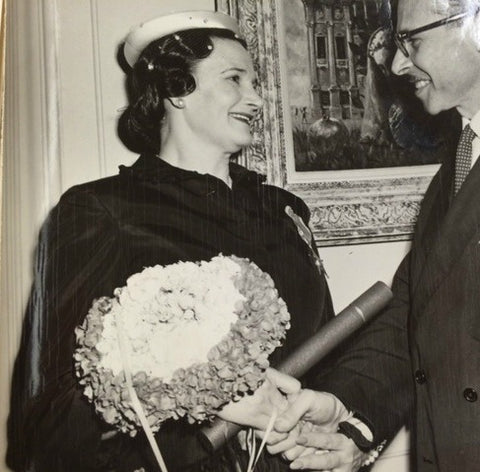Petite Origins: Hannah Troy
Posted by Betsy C on

Petites are rather a new-fangled concept in the context of fashion history. I used to think of the petite section of the department stores was limited to just my grandmothers demographic. However, in recent years petite fashion has had a resurgence and is gaining momentum as retailers (and SBCC patterns) looks to cater to the petite population which can theoretically represent 70% of the female market. It’s not that we are special, the fact is plain- we want clothes that fit!

Photo Courtesy of FIT Special Collections
Gather round my storytelling circle as we travel back to 1940 where Hannah Troy was a designer for women’s blouses in the NYC garment district. She found that her customer suffered from ill-fitting garments because most women tended to be short-waisted. She was on to something, and had a hunch that sizing standards thus far were clearly in error. Following her hunch she delved into government statistics which were based on the women entering the military service during WW2 who were measured and recorded. What she found was staggering and confirmed her theory: only 8% of women possessed the “ideal” proportions and instead, over 2/3 of those surveyed were short-waisted.
Ms.Troy thus pursued her ambition for petites by creating a line called “Troy Figures,” which were based on a junior type of fit, but with a mature outlook. It was intended to be a fit with a higher waist level and unchanged bone structure from junior fit, but rounder with more flesh on the bones. When asked why she chose the term “Petite” to categorize her styles she responded “It had a nice ring to it. I’ve regretted it ever since.” Now the Troy Figures line was intended to fit short-waisted women of all heights, but only shorter women bought the clothing and women over 5’7″ would not even try them on. However, the concept was still novel and was duplicated by competition to become known as we know it today, for proportionally smaller women. Even today, designers and retailers all have their own formulations how to draft for petites, but Ms. Troy’s success was based on a carefully guarded numeric proportioning- which I would die to get my hands on by the way- but it seems to have disappeared into the mist of fashion history to only be speculated upon.

Photo Courtesy of FIT Special Collections
She did not just stop at petites, but was a force in bringing Italian fashion to the forefront and spotlighting Italian manufacturing. She also designed gowns for society ladies and those of important stature, such as President Nixon’s wife and served as the first female board member at the Fashion Institute of Technology, only retiring in 1967 and passing away in 1993.

Photo Courtesy of FIT Special Collections
Within my research resources Hannah Troy is a rather elusive figure in fashion history with minimal information available about her. I am saddened by this fact as her invention opened the door to special sizing; not just for petites – plus sizes,talls, as well. I have many reference sources available- FIT archives and special collections (many thanks to them!) The Brooklyn Museum, The Metropolitan Museum of Art to name a few, but all have basically the same information. I would love to know more and am still in process of investigating her story and work.
Share this post
- 2 comments
- Tags: Blog
2 comments

Thank you so much for writing this article. Hannah was my grandmother and we were very close. She died when i was 19. While I admired her very much as an entrepreneurial woman in a time when there were so few, I know little about that aspect of her. Most of what was passed down to me are newspaper clippings and photos. Im looking forward to delving into it and seeing what else i might find. Thank you for teaching me more about a woman who was so dear to me.
Thank you for this information! I just bought at fleamarket a Hannah Troy -dress from 50s. It is in perfect condition. And it fits me like measure-made! No need to say: I wear petite sizes.